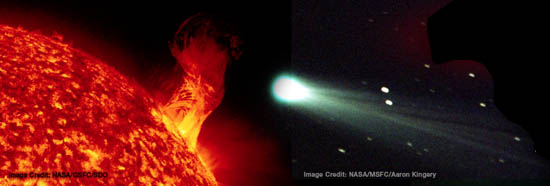home | internet service | web design | business directory | bulletin board | advertise | events calendar | contact | weather | cams

|
Comet and Family Over the last few months Comet ISON has graced our morning skies and delighted many astronomers. However, the comet may disintegrate as it orbits closely to the sun this Thursday--a day we like to call Thanksgiving. ISON, I know how you feel.  This NASA composite image shows comet ISON as it approaches the sun. This NASA composite image shows comet ISON as it approaches the sun.Many around America will take the annual trip to their respective homelands for food, drinks, and the opportunity to see little cousin Jimmy laugh until he shoots milk out of his nose yet again. A close graze with the glowing nucleus of our familial system isn’t necessarily the easiest thing to weather. Comet expert John Bortle said the “solar pass can disrupt and evaporate a comet’s nucleus completely.” Well, I could say the same about family gatherings. If they do not completely annihilate your soul, you will be better off for surviving them. As I think about the comet’s big day, I can’t help but feel a little jealous that it travels at almost 248 miles a second while we sit in stop-and-go traffic on the upward side of a mountain pass with whiners and seat-kickers as entertainment. I’d wager ISON’s view of the expansive solar system is more exciting than the miles of vehicles spitting and farting in queue. Recently, Comet ISON has been observed as having an “outburst,” becoming substantially brighter due to its release of H2O and CO2. Well, my fiery friend, I can’t really blame you. They are bound to happen now and again during this time of year. With the holidays coming and family joining together, critical mass in one form of another is bound to occur. And under the pressure, a little outburst is inevitable. On Thanksgiving Day, astronomers theorize that the comet will sustain temperatures over 5000 degrees Fahrenheit. That may be considered a touch warm in comparison to a mother’s kitchen, though not quite hot enough to fully cook a turkey. But what will happen to this comet once it wipes its feet on the Sun’s doormat? The Comet ISON Observing Campaign scientifically claims, “We have no idea.” However, there are a few things that we terrestrials can rely on this holiday. There will be food. There will be family or friends. And should you return to your family home, you will feel like you are twelve again. Being ISON does have its perks, though. The comet, even at the grown-up age of 33, will not be relegated to the Lilliputous children’s table. Sure, the conversation might be a bit more lively and the Martinelli’s might flow like wine, but the tiny chairs and the knee pain can be a bit cumbersome. Once Thanksgiving passes, should ISON survive, it should be brighter and more visible to the naked eye. I’d like to think that this is a scientist’s way of offering hope. If we should survive Thanksgiving, we’ll be a little brighter and a little more spirited throughout the holiday season. If... And if you manage to sleep off your tryptophan jag and wake up early on Friday, you’ll be able to see Comet ISON in the early morning sky on the eastern horizon. Hopefully. 11/27/2013 EDITOR'S NOTE 11/29: Uh-oh, the latest reports say that ISON didn't make it past the sun. We hope your own Thanksgiving journeys went better. EDITOR'S NOTE 12/2: What!?!? Now scientists are snooping and muttering around, trying to decide how much—if any—of the comet made it past the sun on Thanksgiving Day. Comments
|